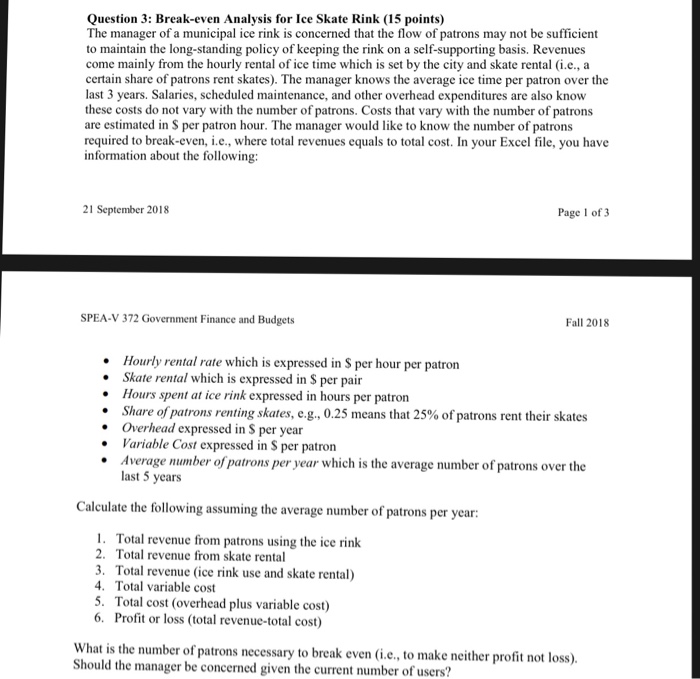Question 3: Break-even Analysis for Ice Skate Rink (15 points) The manager of a municipal ice rink is concerned that the flow of patrons may not be sufficient to maintain the long-standing policy of keeping the rink on a self-supporting basis. Revenues come mainly from the hourly rental of ice time which is set by the city and skate rental (i.e., a certain share of patrons rent skates). The manager knows the average ice time per patron over the last 3 years. Salaries, scheduled maintenance, and other overhead expenditures are also know these costs do not vary with the number of patrons. Costs that vary with the number of patrons are estimated in S per patron hour. The manager would like to know the number of patrons required to break-even, i.e., where total revenues equals to total cost. In your Excel file, you have information about the following: 21 September 2018 Page 1 of 3 SPEA-V 372 Government Finance and Budgets Fall 2018 Hourly rental rate which is expressed in S per hour per patron Skate rental which is expressed in S per pair Hours spent at ice rink expressed in hours per patron Share ofpatrons renting skates, e.g., 0.25 means that 25% of patrons rent their skates Overhead expressed in S per year Variable Cost expressed in S per patron . Average number of patrons per year which is the average number of patrons over the last 5 years Calculate the following assuming the average number of patrons per year I. Total revenue from patrons using the ice rink 2. Total revenue from skate rental 3. Total revenue (ice rink use and skate rental) 4. Total variable cost 5. Total cost (overhead plus variable cost) 6. Profit or loss (total revenue-total cost) What is the number of patrons necessary to break even (i.e. to make neither profit not loss) Should the manager be concerned given the current number of users? Question 3: Break-even Analysis for Ice Skate Rink (15 points) The manager of a municipal ice rink is concerned that the flow of patrons may not be sufficient to maintain the long-standing policy of keeping the rink on a self-supporting basis. Revenues come mainly from the hourly rental of ice time which is set by the city and skate rental (i.e., a certain share of patrons rent skates). The manager knows the average ice time per patron over the last 3 years. Salaries, scheduled maintenance, and other overhead expenditures are also know these costs do not vary with the number of patrons. Costs that vary with the number of patrons are estimated in S per patron hour. The manager would like to know the number of patrons required to break-even, i.e., where total revenues equals to total cost. In your Excel file, you have information about the following: 21 September 2018 Page 1 of 3 SPEA-V 372 Government Finance and Budgets Fall 2018 Hourly rental rate which is expressed in S per hour per patron Skate rental which is expressed in S per pair Hours spent at ice rink expressed in hours per patron Share ofpatrons renting skates, e.g., 0.25 means that 25% of patrons rent their skates Overhead expressed in S per year Variable Cost expressed in S per patron . Average number of patrons per year which is the average number of patrons over the last 5 years Calculate the following assuming the average number of patrons per year I. Total revenue from patrons using the ice rink 2. Total revenue from skate rental 3. Total revenue (ice rink use and skate rental) 4. Total variable cost 5. Total cost (overhead plus variable cost) 6. Profit or loss (total revenue-total cost) What is the number of patrons necessary to break even (i.e. to make neither profit not loss) Should the manager be concerned given the current number of users







